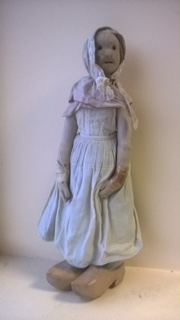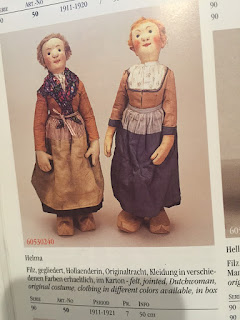"Dear Steiffgal,
Please give me your advice on this doll! It was given to my Grandmother by a Prisoner of War (POW) who was living in the German POW camp in Dorset around 1910-1914. My Mum was told that the POW had made it. At that time the POWs were allowed to mix in the community and some even helped local trades.
This doll has all similarities of Steiff, though it is stuffed with straw. I was wondering could of maybe have been a Steiff worker who had been captured during war duty. Maybe he had access to a sewing machine (maybe a trade in the village?) and made it?
She is beautifully stitched and hand stitched up. She came with knitted socks, wooden clogs, bloomers, combinations, a lemon blouse (missing), a petticoat, a skirt, apron and lace edged bonnet. She stands about 50 cm tall, and has human hair woven into her scalp.
 We undressed her for the first time in nearly 70 years, as you can see she is a bit rough but both my Grandmother and my Mum played with her, my Mum mended her broken bits when she was 7-8 so they are roughly done but do the job. I have contacted Steiff and they say that she definitely looks the part.
We undressed her for the first time in nearly 70 years, as you can see she is a bit rough but both my Grandmother and my Mum played with her, my Mum mended her broken bits when she was 7-8 so they are roughly done but do the job. I have contacted Steiff and they say that she definitely looks the part. So glad my Mum hung onto her, I think she's lovely.
Best, Suzie"
This sweet doll is a double Dutch treat indeed! From her appearance, construction, and proportions, it is Steiffgal's gut feeling that she indeed was made by Steiff in Germany. And her detailing aligns with a well known Steiff doll named Helma, who is pictured here on the left. The photo is from Pfeiffer's Sortiment 1892-1943. Like Suzie's doll, Helma is 50 cm, made from felt, is fully jointed, excelsior stuffed, has a mohair wig, and features Steiff's legacy center seamed face construction. Helma wears a traditional Dutch outfit, complete with wooden clogs. According to Steiff records, her outfit was made in a variety of different colors and fabrics, which is why Suzie's doll's clothes don't exactly match the reference photo. Helma was produced from 1911 through 1921; her black shoe button eyes put her at the earliest end of this manufacturing timeline. So if Suzie's Grandmother received the doll in the 1910-1914 time frame, the logistics do indeed align.
In addition to Helma, Steiff also produced two other 50 cm, clog wearing Dutch adult dolls around the same time period. The first was Franz, a fisherman. The second was Knut, who was dressed like a local farmer and wore a fur cap. Both Franz and Knut had distinctive mohair beards. These large Dutch dolls were specifically designed as hardworking adults with grown-up personalities.
As for the mystery of how Suzie's Grandmother's doll got to Dorset, or if the POW made it... well, only the doll knows for certain! It is most unlikely that the POW personally constructed the doll in Dorset. Maybe they or a family member worked at Steiff in Germany, and for some reason they had the doll with them when they were sent off to the camp. Another possibility is that the POW made some of the clothes or other accessories for the doll and not the actual doll... or that they made the money to buy the doll, either in Germany or near Dorset. The details of any of these scenarios may have simply gotten lost in translation - or time.
Steiffgal hopes this discussion on Suzie's third-generation doll has been a delightful family affair for you.



